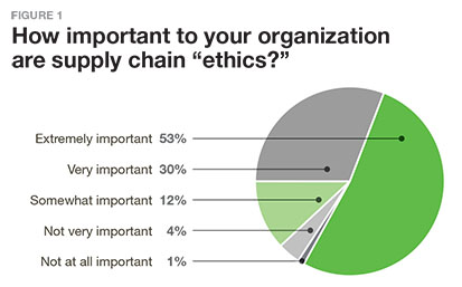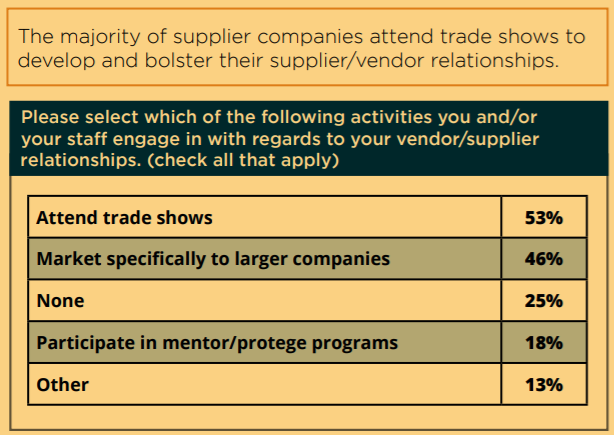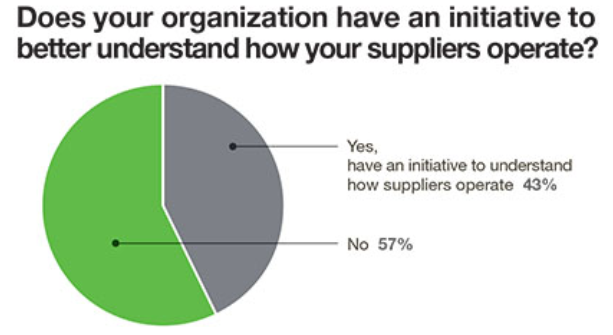
You already know your business needs vendors to operate. But a good, strong relationship greatly benefits both you and your vendors.
Researchers from Motilal Nehru National Institute of Technology have found that suppliers in collaborative relationships with business buyers outperform their competitors. And if you’ve worked with vendors before, then it won’t surprise you that the organizations consuming those goods and services (that’s you) also perform better.
The synergy is real, and it’s one of the best ways to fuel your company’s growth. An investment in your supplier relationships is an investment in your own business. Strong partnerships are assets that appreciate over time. Here are 6 steps to maximize the benefits for your own organization.
1. Own your own procurement
Procurement service firms make a strong case for handling your vendor relationships, and the trend is growing.
The number of businesses contracting out their vendor management grew from 15% to 29% in two years.
That said, we believe “outsourcing your outsourcing” is a big mistake.
The main reason we discourage hiring a procurement service is, when you do, you relinquish the benefits of quality control. Procurement services can employ foreign vendors that are unregulated, increasing your risk of supply chain irresponsibility. This could mean data protection and processing missteps, raw material defects, and even the use of toxic substances in your products.
Another reason to own your vendor relationships is without a direct line, communication suffers. Want to talk to your end service provider or raw materials supplier? A middle man complicates that.
Finally, avoid outsourcing procurement because your customers care. Business leaders are increasingly monitoring ethics because, according to the Supply Chain Management Review, “Consumers are now demanding to know that the products they buy are made in socially, ethically and environmentally conscious ways. Social media amplifies this ability and the negative blowback by providing quick access to information that can sway purchasing decisions.”

Source: Supply Chain Management Review
Owning your procurement may mean more involvement from you, but that involvement drives growth. You’ll control the quality of your product or service; you’ll enjoy direct communication, which enables real-time decision making; you’ll reduce the many risks of supply chain irresponsibility.
2. Get a great vendor management solution (VMS)
If you haven’t already, invest in a system that streamlines work for both you and your suppliers.
Small and mid-size businesses (SMBs) spend 45% to 65% of their income on goods and services.
Organizing the procurement and vendor management process with a program that will scale with you is the quickest and least complicated way to cut down on this cost (and prevent it from outgrowing its budget in the future).
Here’s how the right VMS can help grow your business:
- • Automate the tedious portions of supplier management (like sourcing, vetting, onboarding, and paying) to reroute energy to relationship-building activities.
- • Increase visibility into all your vendors, sorting and filtering them by custom criteria for on-the-fly decision-making.
- • Manage permissions to allow only the appropriate internal people to grant approvals.
- • Measure performance against pre-determined metrics.
- (Back to Top)
3. Build (or rebuild) mutual trust in your vendor relationships
You want to “get the most” out of your vendors. But without mutual trust, tactics and tricks are ineffective at best and dangerous at worst. That means you must earn trust before you can expect it in return.
Refocus on fundamentals
Start by paying your bills on time. Many business owners make late payments. And according to the Credit Protection Association Limited, 90% of of them blame this dodgy conduct on the late payments of their own customers.
Blaming external circumstances (and others) instead of holding yourself accountable is bad for business.
Next, provide your vendors with the information they need to perform. To support you, vendors and agencies need a lot of information. Most business owners expect this investment upfront but fail to realize suppliers need an ongoing knowledge migration. Set aside a few minutes on your calendar each week to review the original details and the most recent update you gave. Has anything changed? If so, communicate it immediately.
Convey your expectations, needs, and praises early and often. Your new review process (mentioned a moment ago) also provides the opportunity to describe new desires, expectations, and anything you’ve noticed your vendor doing particularly well.
Avoid letting impersonal technology dehumanize your relationship
The Motilal Nehru National Institute of Technology researchers also found that
Face-to-face communication is linked to mutual supplier/buyer trust, which in turn boosts the performance of both organizations.
But if face-to-face communication is key, then obviously, we have a problem. The events of 2020 have — to put it lightly — complicated that tactic. In fact, before 2020, in-person events like trade shows were the number-one relationship-building tactic for vendors.

Source: National Small Business Association’s 2017 Small Business Workforce and Labor Survey
It’s tempting to move communications directly to text, email, and your new vendor management tool. But textual interactions hamper tone and intent. Instead, use video conferencing tools to keep face-to-face communication going.
Video calls are more expressive than (and these days, just as easy as) phone calls. When you meet regularly for briefings, let your vendor see your face and surroundings. For informal instances, use the native video calling feature on your mobile device to humanize these impromptu conversations.
Learn your vendors’ business (and show that knowledge)
Most (57%) businesses don’t have a plan or intention to understand vendors’ business models or operations.

Source: Supply Chain Management Review
The best way to do this is to simply ask. While your supplier won’t spend all day schooling you on their business model, they can give you an overview.
Questions to Ask Your Vendors:
- • How the business makes money
- ⸰ Whether there are any secondary sources of income, and what they are
- • Where the company spends most of their resources and how your vendor has gotten creative to stymie increases in costs
- • What their values are, and how their policies align with these priorities
- • How current events have affected their operations
- • What ways you, as a client, can support any of these points
After you’ve learned a little about the vendor’s industry, keep an eye on business headlines in their sector. Look out for new developments that may affect them. Over time, you’ll learn common industry standards. Congratulate your vendor when you see they’re overdelivering against those standards.
Building trust fuels growth by solidifying mutual commitment. This diminishes costly vendor turnover rates, letting you funnel those funds into more growth-oriented activities.
4. Negotiate, clarify, and enforce every detail
As coach John Wooden famously said, “It's the little details that are vital. Little things make big things happen.” Nowhere is this more true than in enduring, impactful business relationships. Fortunately, we have a lot of influence over the little things.
Negotiate: Navigate to “yes”
There are always ways to come together, so both parties win. All it takes is a little creativity and benevolence. For example, paper checks can take up to two months to clear, so go digital and split the fees. One business leader wires money to an overseas vendor and pays the cost but lets his vendor pay the PayPal fees for using that medium.
Another example is the conundrum of volume discounts. You want that lower price, but your vendor can’t justify swallowing the cost.
You may find yourself in this catch-22, where suppliers won’t give you the volume discounts they offer enterprise-level organizations. In this situation, consider forming a small consortium with other professional peers. Inspirational real-life models of this include:
- • The E&I (Educational and Institutional) Co-op, a member-owned nonprofit that helps their participants source security solutions, logistics contracts, and, more recently, bulk PPE supplies.
- • Infosys describes a co-op of automotive and mining industry businesses that formed a group to leverage their collective bargaining power for better deals on mission-critical MRO (maintenance, repair, and overhaul supplies) and chemicals.
In his classic book The 7 Habits of Highly Effective People, Stephen Covey says this about negotiations: “Anything less than Win/Win in an interdependent reality is a poor second best that will have impact in the long-term relationship. The cost of that impact needs to be carefully considered. If you can’t reach a true Win/Win, you are very often better off to go for No Deal.”
Clarify: Prioritize documentation
Among supplier relationship specialists, 37% report higher vendor engagement when they create documented processes for their team to follow.
We’ve already discussed the perils of paying vendors late. You can preempt doubt by asking what terms your vendor prefers — and then honoring them. Use your new vendor management software to set up payment schedules according to your supplier’s wishes. Consider recording your oral affirmations of understanding to supplement your signature on agreements.
Finally, demonstrate your understanding of payment options by paying early the first few times and whenever you can in the future. Talk with your accountant to ensure your cash flow can handle a proactive move like this.
Remember, no one regrets having good records of what happened in business (unless, of course, they’re trying to hide something). One of the best ways to document your strengthening vendor relationship is to create and keep favorable payment schedules.
Enforce: Comply yourself before imposing rules on your vendors
When business customers hear “enforce,” they often assume the vendor needs accountability. But building profitable vendor relationships means you tackle and prevent your own shortcomings first.
Survey your own adherence to your vendor agreement before questioning your suppliers’ — assume your processes need tightening first. Once fixed, then deal with your vendor’s noncompliance.
Ask your vendors about their self-review process and implement a scorecard of your own (together) that’s unique to your partnership and specific goals.
Then, add a routine time to your calendar to review this and congratulate your supplier or agency on any improvements or wins you see. This lays a foundation of trust, so it’s solid when you do need to mention any grievances.
Negotiating, clarifying, and enforcing your vendor agreements prevents costly miscommunications and missteps. These savings can also be used to fund customer acquisition or retention, directly driving growth that lasts.
5. Make it a long-term relationship
As with any investment, you must sacrifice short-term costs to reap the benefits in the long-term. Acknowledge this, and investing in your vendor relationships becomes much more enjoyable for everyone involved. In fact, experts from CIO.com say that
Failing to view vendors as long-term strategic partners imperils both businesses.
One way to convey your sustained commitment to your vendor is to give them a measured look into your 6- and 12- month plans. They may be considering upgrading their own systems and processes, and knowing you plan to involve them in your future could convince them to make that investment.
Another way to build relationship equity is to send your vendors referral business. If they’re performing well for you and don’t seem stretched thin, why wouldn’t you give them a boost?
Vendor turnover is as painful — if not more painful than — employee turnover. It takes precious time and resources to source, vet, and onboard new suppliers and service providers. Saving this cost allows you (and your vendors) to grow faster and sustainably.
6. Reap the benefits
McKinsey reports that businesses with collaborative supplier relationships grow at double the rate compared to their competitors.
To learn more about improving your vendor relationships to fuel business growth, watch the live webinar recording below.
And to determine what vendors you can afford, to learn how to wrangle them all, and to manage all the mutual success, contact Ignite Spot today. Our team of outsourced accountants can guide you through finding and developing the very best suppliers for reciprocal wins.













.png)




